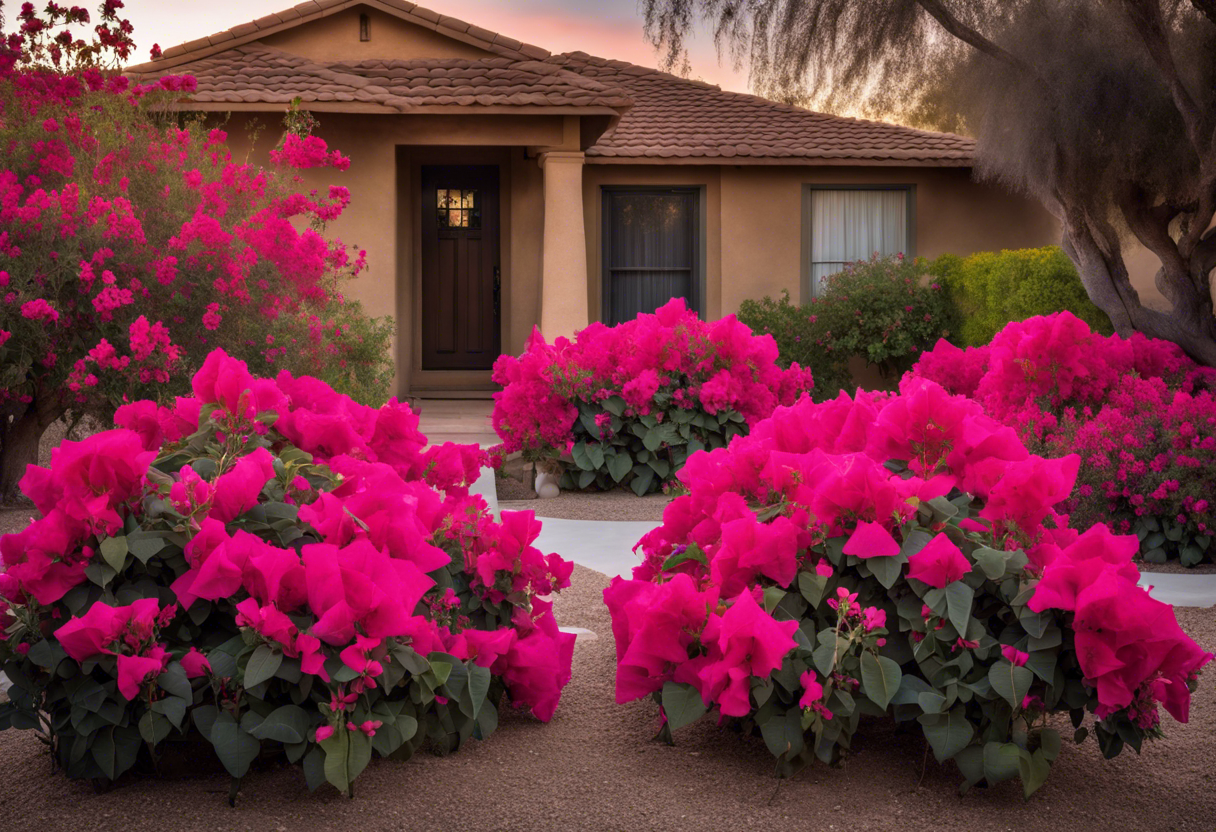Ever had that moment when you step outside to admire your garden and the vibrant bougainvillea, only to find it looking more like a sad popsicle than the tropical beauty it is? I’ve been there, done that. And let me tell you, learning how to Protect Bougainvillea from Frost was a game-changer!
So, buckle up folks! We’re about to embark on a journey of frost-fighting tips and tricks that’ll keep your bougainvillea blooming even when Jack Frost comes knocking. Keep reading about ‘How to Protect Bougainvillea from Frost?’
Key Takeaways
- Protect bougainvillea from frost by moving potted plants indoors or covering ground plants with frost cloths.
- Water the plant thoroughly before a freeze to insulate the roots.
- Apply a layer of mulch around the base to retain heat.
- Use anti-transpirant sprays to reduce water loss from leaves.
- After a frost, resist pruning damaged parts immediately as they can provide protection for the rest of the plant.
Understanding Bougainvillea and Frost
Bougainvilleas are vibrant, tropical beauties that can’t stand the cold. They’re like your friend who always complains when the temperature drops below 70 degrees. These plants have a low tolerance for frost, which can cause significant damage.
What is Bougainvillea?
So, what’s a bougainvillea? Well, it’s a sun-loving plant that hails from South America. It’s known for its brilliant colors and cascading blooms. You’ve probably seen them in shades of pink, red, orange, purple – you name it!
There are many varieties of this plant. Some are compact and perfect for pots while others love to climb and cover walls or fences. But no matter the variety, they all share one thing: a distaste for cold weather.
How does frost affect Bougainvillea?
Now let’s talk about how frost affects these warm-weather lovers. When temperatures drop too low, bougainvilleas start to feel the chill. The first sign of trouble is usually wilting leaves.
If the cold continues, those leaves might turn brown or black – that’s frost damage right there! And if things get really bad? Your beautiful bougainvillea could lose all its leaves or even die.
Remember folks, protecting bougainvillea from frost isn’t just about keeping them pretty – it’s about keeping them alive!
Preparing for Frost

In the world of gardening, preparation is key. Especially when it comes to protecting bougainvillea from frost. You see, these vibrant beauties aren’t big fans of the cold. So, keeping an eye on weather forecasts and understanding frost warning signs can be a real game-changer for your bougainvillea frost protection strategy.
Checking weather forecasts regularly
Now, you might be thinking, “Weather forecast? Really?” But let me tell you, this isn’t just about deciding whether to carry an umbrella or not. It’s about weather forecast gardening, my friend! Regularly checking the weather can help you predict potential frost and prepare your bougainvillea accordingly.
It’s like having a crystal ball that tells you when to start your bougainvillea cold protection measures. And who wouldn’t want that? Plus, with all the fancy apps and websites out there, garden temperature monitoring has never been easier!
Understanding the signs of an impending frost
But what if you’re more of a hands-on gardener who prefers nature’s signals over technology? Well, then it’s time to learn how to read the signs of an impending frost. Yes, Mother Nature gives us plenty of cues if we know where to look.
For instance, clear skies and dropping temperatures in the evening could mean Jack Frost is planning a visit. Recognizing these frost warning signs can give you enough time to protect your bougainvillea from freezing temperatures.
So remember folks – stay vigilant and keep those green thumbs ready! Your bougainvilleas are counting on you to shield them from the icy grip of winter!
Protective Measures Against Frost
It’s vital to protect Bougainvillea from frost. These tropical beauties are sensitive to cold, and a bit of frost can cause serious damage. But don’t worry, there are several ways to prevent frost damage and ensure your bougainvillea thrives throughout the winter.
Using frost cloths or blankets
Frost cloths or blankets are a gardener’s best friend when it comes to bougainvillea winter care. They’re designed to trap heat from the ground and keep your plants warm during those chilly nights.
Just drape the cloth or blanket over your bougainvillea, making sure it reaches all the way down to the soil. This ensures that any heat radiating from the ground is trapped under the cloth, keeping your plant cozy and warm.
But remember, while these cloths offer great freeze protection for plants, they aren’t foolproof. If temperatures drop too low for too long, even a frost cloth might not be enough.
Creating windbreaks or barriers
Windbreaks or barriers can also help protect Bougainvillea from frost by shielding them from icy winds. Cold winds can exacerbate frost damage by stripping away any warmth your plant has managed to hold onto.
Creating a windbreak can be as simple as setting up a few stakes around your bougainvillea and attaching a tarp or heavy-duty plastic sheeting. Just make sure it’s sturdy enough to withstand strong winds without toppling over!
Remember though, while windbreaks are effective at reducing frost damage, they won’t provide complete protection if temperatures plummet below freezing.
Applying anti-desiccant sprays
Anti-desiccant sprays play an important role in winterizing bougainvillea with sprays. They work by forming a protective coating on the leaves of your plant, preventing moisture loss and helping to protect against frost damage.
To use, simply spray your bougainvillea thoroughly, making sure to cover all leaves and stems. It’s best to apply these sprays in the late fall or early winter before the first frost hits.
But keep in mind, while anti-desiccant sprays can help prevent moisture loss, they won’t provide complete protection against severe cold. So be sure to combine them with other protective measures like frost cloths and windbreaks for the best results!
Post-Frost Care for Bougainvillea
When Jack Frost has had his way with your bougainvillea, don’t despair! Post-frost care is crucial to help your plant bounce back. It’s all about assessing the frost damage and nursing your frost-damaged bougainvillea back to health.
Assessing the Damage After a Frost
So, how do you tell if your bougainvillea has been nipped by the cold? Look out for wilted leaves or discolored blooms – these are classic signs of frost-bitten bougainvillea.
Next, assess the extent of the damage. If only a few leaves are affected, you’re in luck! But if it’s more widespread, it might be time for some serious bougainvillea care after winter.
Pruning and Caring for Frost-Damaged Bougainvillea
Now onto the fun part – pruning! Grab those shears and start snipping off damaged parts. This isn’t just about aesthetics; pruning helps promote new growth and recovery in your frosted bougainvillea.
After pruning, give your plant some TLC. This means plenty of water (but not too much!), sunlight, and maybe even a pep talk or two. With proper care, you’ll soon see your cold-hit bougainvillea thriving again! Remember to always protect Bougainvillea from frost, so you won’t have to go through this rigmarole next winter!
Indoor Protection of Bougainvillea During Winter
When Jack Frost starts nipping, it’s time to protect Bougainvillea from frost. But how do you do that? Well, one way is by moving your potted beauties indoors. It’s all about mastering the art of indoor Bougainvillea care and ensuring they get the right light and temperature.
Moving potted Bougainvillea indoors
So, you’ve got a potted bougie (that’s slang for bougainvillea) and winter is coming. What now? Time to start moving Bougainvillea indoors! But hold up, don’t just yank them off their cozy patio spot. Be gentle when handling potted Bougainvillea, they’re sensitive souls. And remember, timing is everything – move them before the first frost hits. Once inside, find a nice sunny spot for them; after all, these are sun-loving plants we’re talking about here.
Providing adequate light and temperature indoors
Now that your bougies are safely indoors, it’s time to focus on maintaining their new environment. They need plenty of light so make sure they’re near a window or under a grow light if necessary – yes, indoor light for Bougainvillea is crucial! As for temperature, keep it above 60°F (16°C). Any colder and they might catch a chill! So there you have it folks – the basics of winter care for indoor bougies! Just remember: right light + warm temps = happy indoor bougies!
To Wrap Up
Just like you’d swaddle a baby, your bougainvillea needs some TLC to survive frosty nights. Remember to water, cover, and insulate these tropical divas before Jack Frost comes a-knocking.
For more tips on how to Protect Bougainvillea from Frost, check out this handy guide. Because let’s face it folks, nobody likes a wilted party guest!


